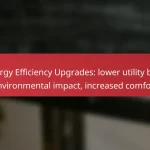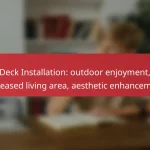Deck installation enhances outdoor living by providing a dedicated space for entertainment and relaxation, transforming backyards into inviting areas for social gatherings. By expanding living areas, decks not only improve functionality but also elevate the aesthetic appeal of your home, creating a seamless transition between indoor and outdoor spaces.

How does deck installation enhance outdoor entertainment in the UK?
Deck installation significantly boosts outdoor entertainment by creating a dedicated space for socializing and relaxation. It transforms backyards into inviting areas for gatherings, enhancing both functionality and aesthetic appeal.
Increased space for gatherings
A well-designed deck provides ample space for hosting family and friends, accommodating everything from casual barbecues to formal dinners. This additional area can comfortably fit seating arrangements, tables, and even outdoor kitchens, allowing for seamless entertaining.
When planning a deck, consider the size and layout to ensure it meets your entertaining needs. Aim for at least 20-30 square meters for a functional space that can host multiple guests without feeling cramped.
Improved outdoor aesthetics
Decks enhance the visual appeal of outdoor spaces, offering a polished look that complements landscaping. Materials such as wood, composite, or even stone can be selected to match the style of your home and garden.
In the UK, choosing weather-resistant materials is crucial due to the climate. Opt for treated timber or high-quality composites that can withstand rain and humidity while maintaining their appearance over time.
Integration with outdoor furniture
Decks serve as a perfect foundation for outdoor furniture, allowing homeowners to create comfortable and stylish seating areas. Selecting the right furniture can enhance the overall experience, making the space more inviting.
Consider modular or stackable furniture for flexibility, especially in smaller gardens. Ensure that the furniture is weather-resistant and easy to maintain, allowing for year-round use without extensive upkeep.

What are the benefits of expanding living areas with decks?
Expanding living areas with decks offers numerous advantages, including enhanced outdoor entertainment options, increased property value, and improved aesthetic appeal. Decks create a seamless transition between indoor and outdoor spaces, making them ideal for gatherings and relaxation.
Seamless indoor-outdoor flow
Decks facilitate a smooth connection between your home’s interior and the outdoor environment. This flow encourages more frequent use of outdoor spaces, allowing for activities like dining, lounging, and entertaining without feeling disconnected from the indoor comforts.
To maximize this benefit, consider installing sliding or bi-fold doors that open directly onto the deck. This design choice enhances accessibility and creates an inviting atmosphere for guests.
Increased property value
Adding a deck can significantly boost your property’s market value, often yielding a high return on investment. Homebuyers frequently seek outdoor living spaces, making a well-constructed deck an attractive feature that can set your property apart.
In many regions, homeowners can expect to recoup a substantial portion of their deck investment, often in the range of 60-80%. Ensure your deck is built with quality materials and adheres to local building codes to maximize its appeal and longevity.
Versatile usage options
Decks offer a variety of usage options, making them suitable for different activities throughout the year. Whether you envision hosting summer barbecues, setting up a cozy winter retreat with heaters, or creating a garden oasis, a deck can accommodate diverse needs.
Consider incorporating features like built-in seating, planters, or even a fire pit to enhance functionality. This versatility allows homeowners to tailor their outdoor space to their lifestyle, ensuring it remains a valuable asset for years to come.

What aesthetic improvements can decks provide?
Decks enhance outdoor spaces by offering visual appeal, increasing living areas, and creating inviting environments for entertainment. They can transform a plain backyard into a stylish and functional area that complements the home’s architecture.
Customizable design options
Decks can be tailored to fit personal styles and preferences, allowing homeowners to choose from various shapes, sizes, and layouts. Options include multi-level designs, built-in seating, and railings that match the home’s exterior.
Consider incorporating features like lighting, planters, or decorative elements to further personalize the space. Custom designs can significantly elevate the overall aesthetic and functionality of the outdoor area.
Use of quality materials like hardwood
Choosing high-quality materials, such as hardwood, can greatly enhance the visual appeal of a deck. Hardwood options like teak or mahogany offer rich colors and textures that add elegance and warmth to outdoor spaces.
While hardwood may come at a higher initial cost, its durability and longevity often make it a worthwhile investment. Regular maintenance, such as sealing and staining, will help preserve its beauty over time.
Enhanced landscaping integration
Integrating a deck with existing landscaping can create a seamless transition between indoor and outdoor spaces. This can be achieved by aligning the deck with garden paths, flower beds, or trees, enhancing the overall aesthetic.
Consider using complementary colors and materials in both the deck and surrounding plants to create a cohesive look. Additionally, incorporating natural elements like stone or gravel can further enhance the integration of the deck into the landscape.

What are the key considerations for deck installation?
Key considerations for deck installation include understanding local building regulations, selecting appropriate materials, and deciding between professional installation or DIY. Each factor plays a crucial role in ensuring the deck is safe, durable, and aesthetically pleasing.
Local building regulations
Before starting any deck installation, it’s essential to check local building regulations. These regulations often dictate the size, height, and materials allowed for decks, as well as safety features like railings and stairs.
In many areas, you may need a permit for deck construction, which can involve submitting plans for approval. Failing to comply with these regulations can lead to fines or the need to dismantle the deck.
Choosing the right materials
Selecting the right materials is vital for the longevity and appearance of your deck. Common materials include pressure-treated wood, composite decking, and natural wood varieties like cedar or redwood.
Consider factors such as climate, maintenance requirements, and budget when choosing materials. For example, composite decking may have a higher upfront cost but requires less maintenance over time compared to wood.
Professional installation vs DIY
Deciding between professional installation and DIY depends on your skill level, time availability, and budget. Hiring professionals can ensure a high-quality finish and adherence to local codes, but it typically comes at a higher cost.
If you choose to DIY, ensure you have the necessary tools and knowledge to complete the project safely. Many resources are available online, but be prepared for potential challenges, especially with complex designs or large decks.

How to select the best deck for your home?
Selecting the best deck for your home involves considering factors such as space, budget, and maintenance. A well-chosen deck enhances outdoor entertainment, expands your living area, and boosts aesthetic appeal.
Assessing space and layout
Begin by measuring your outdoor space to determine the size and shape of the deck that will fit best. Consider how the deck will integrate with your existing landscape and home architecture, ensuring it complements your outdoor environment.
Think about the layout as well; will you need space for furniture, a grill, or other features? A functional design should allow for easy movement and access to other areas of your yard.
Evaluating budget and costs
Your budget will significantly influence the type of deck you can install. Costs can vary widely based on materials, size, and complexity of the design. For instance, pressure-treated wood may be more affordable than composite materials, but it may require more maintenance over time.
Plan for additional expenses such as permits, labor, and finishing touches like railings or lighting. It’s wise to set aside a contingency fund of around 10-20% of your total budget for unexpected costs.
Considering maintenance requirements
Different decking materials come with varying maintenance needs. For example, wood decks typically require regular sealing and staining to prevent rot and fading, while composite decks are often more resistant to weather and require less upkeep.
Evaluate how much time and effort you are willing to invest in maintenance. If you prefer a low-maintenance option, composite or PVC decking might be the best choice, despite their higher initial costs.










